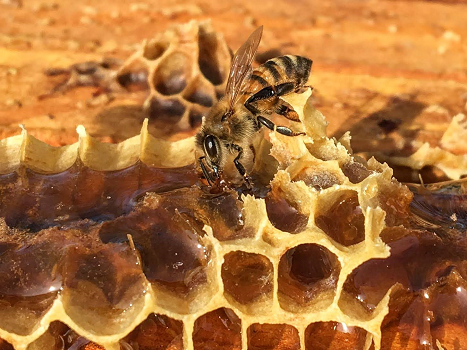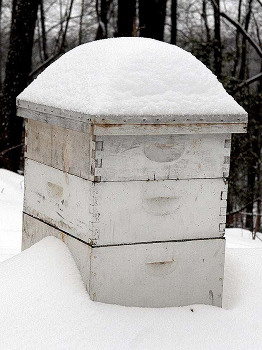|
1 - How to Monitor, Sample, and Treat for Varroa
2 - When to Sample 3 - Sugar Shake 4 - Alcohol Wash 5 - Sticky Board 6 - Disclaimer |

When to Sample for Varroa Mites
Seasonal mite control will differ based on location and various conditions such as temperature, season length, and honey flow.
It is a good idea to sample your colonies regularly throughout the year using the sugar shake, alcohol wash, or sticky board method. This will indicate mite load and the
necessity for Varroa treatment. Treatment is recommended if the sugar shake or alcohol wash results in 3 mites per 100 bees or if there are more than 30 mites per day
on the sticky board.
While some Varroa treatments are temperature specific, it is beneficial to rotate treatments so as not to encourage resistance.
Current EPA-approved Mite Treatments: Amitraz (Apivar), Formic Acid (MAQS), HopGuard, Oxalic Acid, Thymol (Apiguard).
SPRING – March, April, May
Sample colonies in early March.
Bee foraging on almond flower. Photo credit: Emily Watkins de Jong
SUMMER - June, July, August
Colony populations are building during this time of year and so are populations of Varroa mites. This can be a difficult time to treat especially if there is a honey flow. Colonies should be checked monthly for mites. If necessary, colonies may be treated with miticides that are EPA approved for use during the honey flow, otherwise treatment should only be applied once honey is removed.
Bee on honey. Photo credit: Emily Watkins de Jong
FALL – September, October, November
It is VERY important to check colonies more frequently during the Fall. If colonies have high mite loads at this time, they are more likely to crash and potentially die during the winter. Colonies may be sampled every three weeks in the fall, weather permitting. If treatment is necessary, rotate colony treatment by using a different miticide than used
earlier in the year to discourage resistance.
Honeybee foraging on Texas Ranger. Photo Credit: Emily Watkins de Jong
WINTER – December, January, February
Colonies should be left alone or monitored with sticky boards for minimal disruption of the winter cluster.
Winter hive. Photo Credit: Journal-Patriot
| << Previous 1 [2] 3 4 5 6 Next >> |
